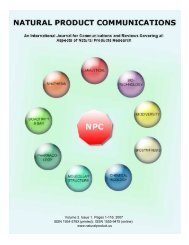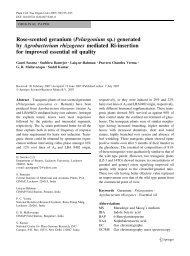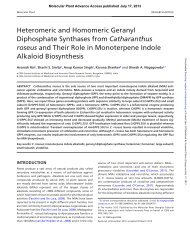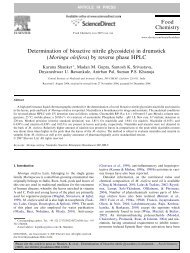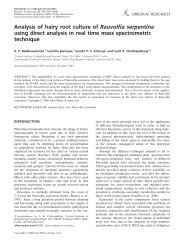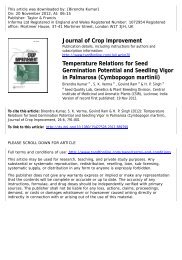Recent advances in plant hepatoprotectives - CIMAP Staff - Central ...
Recent advances in plant hepatoprotectives - CIMAP Staff - Central ...
Recent advances in plant hepatoprotectives - CIMAP Staff - Central ...
Create successful ePaper yourself
Turn your PDF publications into a flip-book with our unique Google optimized e-Paper software.
762<br />
*<br />
NEGI ET AL.<br />
COOH<br />
HO<br />
19<br />
CH 3<br />
Figure 14. Structure ofoleanolic acid (19).<br />
‘‘cherry pie,’’ ‘‘Tick berry,’’ etc., <strong>in</strong> different regions. Oleanolic acid has also been reported from<br />
several other <strong>plant</strong>s like Syzygium aromaticum L., Ocimum basilicum L., Salvia triloba L., etc. It has<br />
been found effective at <strong>in</strong>hibit<strong>in</strong>g carbon tertrachloride <strong>in</strong>duced liver <strong>in</strong>jury. 159 Its effect is associated<br />
with the <strong>in</strong>hibition of carbon tertrachloride biotransformation by the reduced expression of<br />
P450 2E1. 160<br />
C. Ursolic Acid<br />
Ursolic acid (20, Fig. 15) is a common triterpenic acid found <strong>in</strong> the leaves of Eucalytus tereticornis,<br />
Salvia triloba, V<strong>in</strong>ca m<strong>in</strong>or, Ocimum basilicum, etc. It has been reported to have hepatoprotective<br />
activity aga<strong>in</strong>st carbon tetrachloride, ethanol, thiacetamide, and galactosam<strong>in</strong>e damaged liver <strong>in</strong> rats.<br />
Its hepatoprotective action was found to be comparable with silymar<strong>in</strong>. 159–161<br />
H 3 C<br />
CH 3<br />
COOH<br />
HO<br />
20<br />
CH 3<br />
Figure 15. Structure of ursolic acid (20).<br />
D. Berber<strong>in</strong>e<br />
Berber<strong>in</strong>e (21, Fig. 16) is an isoqu<strong>in</strong>ol<strong>in</strong>e alkaloid obta<strong>in</strong>ed from the roots, rhizomes and stem bark of<br />
Berberis aristata DC (Family: Berberidaceae), commonly known as ‘‘barberry.’’ 162 The oxidative<br />
damage <strong>in</strong>duced <strong>in</strong> the hepatocytes by tert-butyl hydroperoxide (t-BHP) was <strong>in</strong>hibited by berber<strong>in</strong>e<br />
probably due to its antioxidant potential. 163,164 In another study, the hepatoprotection activity is also<br />
believed to stem from its <strong>in</strong>hibitory effects on the ion channels of potassium and calcium <strong>in</strong> the rat<br />
hepatocytes. 165<br />
The other recent leads which are reported as emerg<strong>in</strong>g hepatoprotective agents aga<strong>in</strong>st various<br />
hepatotox<strong>in</strong>s have been described <strong>in</strong> Table III.<br />
Medic<strong>in</strong>al Research Reviews DOI 10.1002/med




